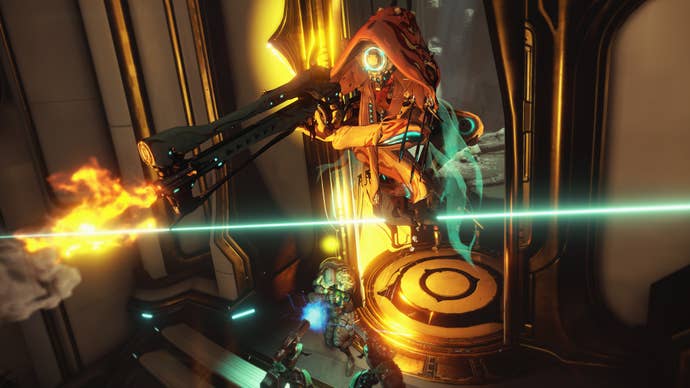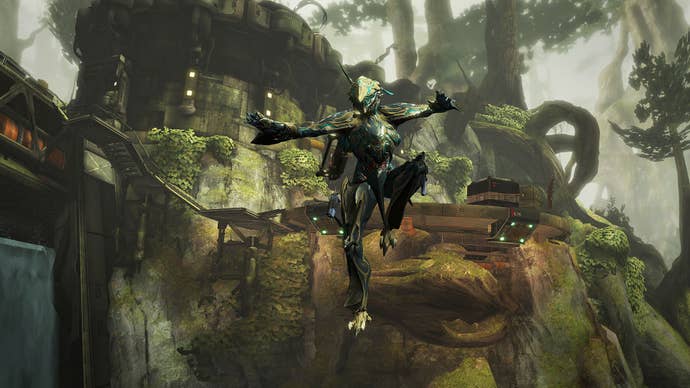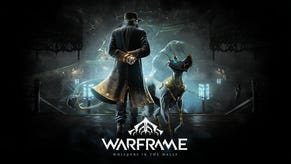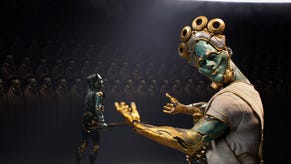Warframe's Journey From Just Another F2P Shooter to One of the Best Games of the Generation
Warframe is five years old, with a new expansion and Switch port under its belt this month. We look back on how it got to this point.
This article first appeared on USgamer, a partner publication of VG247. Some content, such as this article, has been migrated to VG247 for posterity after USgamer's closure - but it has not been edited or further vetted by the VG247 team.
When it launched in March 2013, Warframe was not a good video game. I know this because I played it and it asked me to spend real money to revive my character after a few deaths. I was not amused, the game was not fun, and that, I thought, was the end of that. Five years and five hundred some odd hours later in the game, Warframe has come a long way. It’s one of the best online video games out there, and now, with the recent release of the Fortuna expansion, it’s time to give Warframe another look.
Humble Origins
Warframe might have released in 2013, but developers Digital Extremes had been playing around with the concept in one form or another since 2000. The original iteration of it was an MMO called Dark Sector, but after years of unsuccessful pitch attempts and compromises, it turned the MMO into a more traditional single-player shooter.
Dark Sector is a weird game. You play as Hayden Tenno, a soldier who can’t feel pain and gets infected with a virus that’s turning people into monsters. It plays like a bizarre mix of Gears of War and Resident Evil 4 where your primary weapon is a glaive—a triple-bladed throwing knife. Dark Sector was one of those perfect early 360 generation games where developers were just figuring out the standardized dual-analog control schemes that would define the generation. People seemed to enjoy Dark Sector well enough; it has the coveted “Very Positive” rating on Steam, but it wasn’t enough for Digital Extremes.
If you go back to the original Dark Sector pitch video, you see something that looks a lot more like Warframe. The protagonist, still Hayden Tenno, wears a suit that looks remarkably like Warframe’s mascot frame, Excalibur. Tenno wields a weapon that looks suspiciously similar to Warframe’s Burston while facing off against those gorgeous Grineer designs that didn't show up in Dark Sector, but did make their way back in Warframe. The ideas were there, but the publishers weren’t biting.
For years, Digital Extremes worked on projects for other studios. In 2005, it developed Pariah for publisher Groove Games and worked on its quasi-sequel the next year. It developed the PC port of Bioshock, the multiplayer for Bioshock 2 and Homefront, and made The Darkness 2 in 2012. Digital Extremes was doing well, but it deserved better. As it was winding down work on a Star Trek project, it seemed like all was lost: the studio was getting uncomfortably close to bankruptcy.
But Warframe director Steve Sinclair had an idea. Take the old Dark Sector ideas and art and make a free-to-play game, hoping it would work. Then that didn’t work out either. In the Noclip documentary on Warframe, Sinclair recounts how a publisher suggested it'd worked itself into a corner: the game looked too good. Online games require frequent updates to retain players, but the better a game looks, the more time it takes to make. Warframe looked so good that publishers worried that Digital Extremes wouldn’t be able to update it quickly enough. Other publishers suggested that no one wanted a sci-fi shooter F2P game.
So Digital Extremes decided to make the game by itself. It took about nine months.
How Warframe Works
In a nutshell, Warframe is a game where you and three other players (matchmade or in a party—though you can play solo if you wish) put on your favorite magical space ninja suit equipped with four distinct powers. Trinity, for instance, has abilities for healing and energy projection. Nekros can bring the dead back to life. Each frame has specific theme, and, depending on the mission you’re running, you may want to change frames to suit the objective.

You grind missions for loot and materials. Sometimes, that loot comes in the form of frame or weapon parts or blueprints—I’m trying to get the Revenant Neuroptics blueprint right now by running bounties on Earth—and other times, it drops in the form of mods or crafting resources. Mods are tools you can use to power up your equipment. This is the core of Warframe: get something, then find cool ways to make it better, then go play the game to improve it.
The closed beta was… not great. It had some interesting ideas, but, let’s face it, nine months isn’t a lot of time to make a polished video game. But, since Digital Extremes was out of options, it pushed ahead with it. It wasn’t just about making the game, it was about making sure it could sell the content to players, answer support tickets, and all the other, not-exactly glamorous stuff that is necessary for a great game experience. Players don’t think about it, but this stuff is important; having a smooth experience is everything.
I remember playing fairly early on, and being frustrated by three big issues. First, if you died, you had to pay to revive. Not cool. Nothing was more painfully reminiscent of awful free-to-play timegate mechanics than this. If that weren’t bad enough, players could pay to win, literally. Buying an Orokin Reactor would give players double the power of other players. There were other gripes too, but those were the big ones. My friends and I, who are voracious co-op players looking for anything new and jumping into it with gusto, weren’t too happy about the way the game felt, either.
Movement felt sluggish, wall-running and climbing wasn't responsive or weighty, and the level design and combat lacked the depth I’ve come to expect of good co-op games. It lacked that crucial “it-factor” that made for a great one.
Over the years, I heard news about Warframe. It was a lot more fair now. It added in new planets. I checked it out from time to time. Fans had figured out to move through levels quickly with something called coptering, which I could never get the hang of. Digital Extremes responded favorably, introducing a new mechanic called bullet jumping, which achieved the same effect.
Warframe benefited from the early YouTube games criticism scene as well. YouTube critic and streamer John “TotalBiscuit” Bain gave Warframe a chance, offered some fair criticisms, and told people to check it out. According to the developers at Digital Extremes, this video essentially ‘made’ Warframe. That’s when people really got interested. Releasing it on Steam helped as well.

The secret to any service-based game’s success is a mix of word of mouth and frequent content updates. You want people to play the game frequently and talk about it as often as possible, convincing more friends to join.
Five years after its release, Warframe is barely recognizable as the game that released in 2013. The user interface has been completely overhauled. There are two huge open worlds to explore. Some content, like raids, have been removed completely. Players can now have friendly robot, cat, or dog companions to join them in combat. There are clan hubs to fly to.
At its core, Warframe is a collections game. Grinding each item up to level 30 gives you progress towards your overall player level. Once you rank up, you can build new weapons, earn more resources, do more in-game trades in a day, and a host of other things. This means you’re incentivized to hunt down and level up everything. Sure, you can buy most of these things from the game’s store outright, but you’ll still have to level them up, which means hundreds of hours of play. I’m only at Mastery Rank 20, and I have over five hundred hours in the game.
Warframe masters a “just one more” response. You might find that your current frame isn’t super well suited to, say, a defense mission, so you find a defense frame like Frost and decide to farm it. Maybe you need some special resources to build Frost once you get all the blueprints, so you go to another planet. In the process of doing missions there, you upset some bounty hunters who drop parts for a unique gun. You want to build that gun, so you run a mission type called Wars, since that's what triggers the bounty hunters.
In a game like Destiny, everything resets on either a daily timer, a four day timer, or a weekly timer. Do the raid once, cool, you’re done—no more raid drops for you this week. Run your three strikes, cool, now there’s no reason to run more strikes.
Warframe’s system has a lot more going on. To get an idea of how frequently new stuff pops up, its official Twitter-bot account Warframe Alerts tweets updates for new missions several times an hour. Sometimes, the alerts are unimpressive; getting a few credits here or 80 Endo there might not mean much, but other times, an alert for 300 Oxium or an Ember Backdraft helmet might send you scurrying back into the game to pick it up.
On top of that, you’ve got planetary bounties, which operate on different timers for the two open worlds you can visit right now. Wars, which pop up randomly, grant war-specific resources, and last as long as it takes for players to “win” them. Then you’ve got Sorties, which are daily missions with unique loot tables.

There is always something to do, always something to level up, always something to unlock to improve your mastery even more. Unfortunately, this is where Warframe gets a bit tricky.
In most shooters, a handful of enemies can feel like an immensely satisfying combat encounter, where you’re pulling off headshots and using your abilities, avoiding enemy fire while scavenging the battlefield for the ammunition you need.
In Warframe, you don’t need to be as thoughtful. Run onto the battlefield, make sure your health never hits zero, pop your abilities when you have the energy, and shoot at crowds when you need to. If you can leap past your enemies, just do that; no sense wasting time killing enemies unless your mission is to kill as many enemies as you can. Combat encounters rarely feel like the real focus of the game’s design.
The game can be a mess, but it’s always a glorious mess. I’ve never felt like there was nothing to do. I’ve never felt like I hit my limit. Once I returned to the game in 2016, I never really stopped having a good time with it.
The secret to any online game’s success is whether or not it feels rewarding to play. Warframe might not be able to compete with other shooters when it comes to combat, but it’s so easy to find something to do. Tired of grinding for one thing? Here’s an alert for something else. Want to change things up? There’s almost definitely something to keep your interest. It’s a game that’s so damn playable, so absolutely easy to get into, make tangible progression in, and feel like you accomplished something. Sure, Destiny has better shooting and Ninja Gaiden fulfills that ninja feeling, but nobody challenges Warframe when it comes to flow. The guns are fascinating, the frames feel refreshing to play, and the mastery grind is one of my favorite grinds in video games.
Warframe Listens to Its Players
One of the most difficult things for a developer to do is listen to players, but it’s also a crucial component of making any kind of live, service-based game. One of the issues that Bungie’s Destiny 2 had was that it was too easy for players to exhaust content early on; play content once, get a gun, bam, you’re done with it. There is nothing left to do. You have The Gun You Want, so there is nothing left to earn. Players will often tell you when they’re dissatisfied, but their solutions will rarely actually give them what they want, because players usually only consider one dimension to a problem.
Listening to players is important, but giving them exactly what they ask for is almost never the best solution. Over Warframe’s life, Digital Extremes has listened and conversed with their fanbase, but it's done its best to solve the problems the players are presenting, not necessarily giving players exactly what they ask for. I think this is a big part of the game’s success, and why I returned to Warframe in January of 2016.

Bullet jumping had solved the mobility issue, though the game-feel was still not quite where I wanted it to be. Digital Extremes had added dozens of newer, cooler warframes, like Trinity Prime—a frame I thought was so cool, I paid real money for. (I’ve long-since maxed Trinity Prime out, and I have a new favorite in the form of Ember Prime.) Digital Extremes is always adding new frames, weapons, and ways to play. The new stuff is so well made that it rarely replaces the old; it just gives you a new way to play.
For a while, new content meant new planets, tilesets, and tile set updates, tiles being the individual rooms you explore in Warframe’s randomized levels. Then it meant “cinematic quests,” which are basically traditional video game missions using the Warframe approach. Lately, the big updates have come in the form of open worlds, first with Plains of Eidolon, the big Earth map, and now Fortuna, a map set on Venus.
Not every update works; there’s plenty of content I’ve never really played, either because I didn’t want to or because I couldn’t convince friends to give it a try, like Lunaro, Raids, or The Index. Some content would really benefit from significant updates, like Archwing missions.
But when it works, it really works. When it doesn’t work, Digital Extremes often does what it can to make it work. Plains of Eidolon launched with major issues, but Digital Extremes did its best to solve some of the more pressing bugs as quickly as possible, like objectives not completing or matchmaking simply not working. Sometimes, fans refer to Warframe as “Bugframe,” but there’s no question that Digital Extremes’ heart is in the right place.
One of the best things about the studio is its openness. Too many studios respond to player feedback through complicated corporate speak. Digital Extreme’s devs, in contrast, are refreshingly open. Earlier this year, Sinclair streamed from his phone, killing time answering questions and reading slack updates to the viewers. During Fortuna’s release, he walked around the studio, still streaming from his phone, talking to various developers about the game and joking with Rebb Ford, the community lead, about Rule 34.
As large studios go, Digital Extremes does one of the best jobs humanizing its workforce, rippling a huge impact on its community. While fans of other studios clamor for new games and ignore the stresses developers are often placed under, Warframe’s community rallied around Digital Extremes, asking recently that it not crunch. In my five hundred some-odd hours of playtime, I can’t even remember the last toxic player I encountered. There’s a genuine sense of community and friendship here that makes Warframe even more welcoming to play.
Warframe might just be the best online, service-based game on the market right now. Every single day I log into Warframe with my friends, and we get lost for hours grinding out frames and guns, always finding something new to try. I’m glad Digital Extremes found success with Warframe. With the release of Fortuna and today's Switch release, there’s never been a better time to try it out.


















